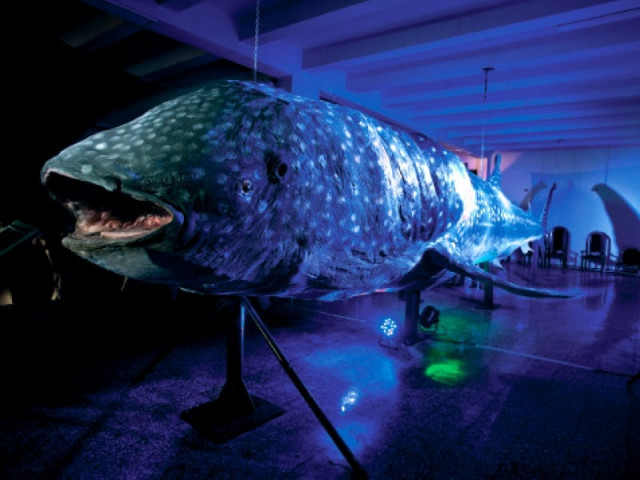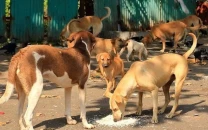It won’t bite: Big fish hooked on display
The whale shark exhibit is open at the PMNH, but the overall environment still leaves something to be desired.

The whale shark exhibit is open at the Pakistan Museum of Natural History, but the overall environment still leaves something to be desired.
A stuffed whale shark — the largest species of fish in the world — has landed at the top floor of the Pakistan Museum of Natural History (PMNH). The enormous fish — found dead off the Karachi coast last year— has been preserved for education and public viewing.
After climbing a fleet of congested stairs to the top floor, a dingy hall welcomes visitors to the shark display. The 40-foot long grey fish with white spots is parked with its mouth wide open, as the museums latest attempt to attract more visitors to the museum.
The whale shark is listed as a vulnerable species by International Union for Conservation of Nature (IUCN). Found in tropical waters, it usually lives in the open sea and can be seen along the coast in many countries close to the equator, going as far south as South Africa, Australia and Argentina, and as far north as the US, China and North Africa.
Although typically seen offshore, it has been found closer to land, entering lagoons or coral islands and near the mouths of estuaries and rivers.
When discovered by the local fishermen on February 6, 2012, near Baba Island in the Arabian Sea, the fish was estimated to be around 50 years old and weighed 16 tonnes.
Experts explained that the migratory fish is capable of diving to depths of at least 1,286 meters. Whale sharks are filter feeders which mostly eat plankton, krill, fish eggs and crabs. For this reason, despite its size, the whale shark does not pose significant danger to humans, though it is still best to avoid getting too close to a live one.

It was brought to Karachi Harbor on February 7, 2012 where the Karachi Fish Harbour Authority (KFHA) and the Marine Fisheries Department (MFD) took possession of it. Zoological Sciences Division Director Dr Muhammad Rafique told The Express Tribune that the first time experience was a success as the experts had to overcome various challenges including the 3D designing and fabrication. “The skin of the fish was four inches thick, which added to the complications.
However the 18-month process brought out the results we were expecting to achieve,” he said.
The skin of the specimen was transported to PMNH and further preservation process continued for more than one year.
The specimen has been reconstructed and mounted with the help from UNESCO. PSF Chairman Professor Dr Manzoor Somroo told The Express Tribune that the taxidermy cost was approximately Rs1 million and Rs800,000 was spent on transporting it to the capital.
Not quite there yet
However, unlike most mounted museum exhibits, the display, or at least the hall itself, reeked of dead fish. There were blue spotlights flashing on the fish and walls covered with pictures of the shark in an attempt to make the less of a distraction from the display, but it was still not up to the mark.
The dimly-lit room had fans, but lacked proper cooling. “We are giving the room an ‘under-the-sea’ theme, so when people walk in, they feel like they are walking underwater,” said Rafique.
The whale shark display is a joint venture of the Ministry of Science and Technology, Pakistan Science Foundation, UNESCO, KFHA and MFD.
The inauguration was planned to coincide with the visit of UNESCO Assistant Director General for Education Dr Qian Tang.
Tang said, “Museums play an important role in popularising science and science education, and I believe PMNH is doing a wonderful job to help educate the masses here. This fish belongs to the whole world and I am proud to be a part of this work” he added.
The specimen is open to the public at PMNH during normal operational hours.
Published in The Express Tribune, July 24th, 2013.


















COMMENTS
Comments are moderated and generally will be posted if they are on-topic and not abusive.
For more information, please see our Comments FAQ